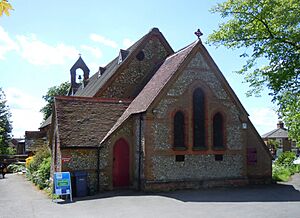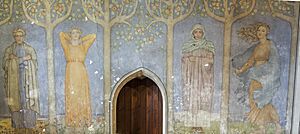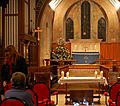St Mark the Evangelist Church, Upper Hale, Farnham facts for kids
Quick facts for kids St Mark the Evangelist, Upper Hale |
|
|---|---|

St Mark the Evangelist
|
|
51°14′06″N 0°48′01″W / 51.235075°N 0.800314°W |
|
| Location | Alma Lane, Upper Hale, Surrey, GU9 9RP |
| Country | England |
| Denomination | Church of England |
| Churchmanship | Liberal Catholic |
| Website | badshotleaandhale.org/ |
| History | |
| Status | Active |
| Dedication | Mark the Evangelist |
| Dedicated | 14 July 1883 |
| Architecture | |
| Functional status | Parish church |
| Heritage designation | Grade II |
| Designated | 10 December 2021 |
| Architect(s) | A.R.Barker |
| Construction cost | £1200 |
| Administration | |
| Parish | Badshot Lea and Hale |
| Deanery | Farnham |
| Archdeaconry | Archdeaconry of Surrey |
| Diocese | Diocese of Guildford |
St Mark the Evangelist Church is a special church in Upper Hale, Surrey. It's part of the Church of England. This church is made of red bricks and has beautiful wall paintings by a local artist named Kitty Milroy. The church first opened its doors in 1883.
Contents
History of St Mark's Church
St Mark's Church was built because of the hard work of John Powell, who was the Vicar of Hale. People in the area helped by collecting flints (small stones) from the common to build the church walls.
The main church, St John's, was far away for many people, especially servants who worked long hours. They couldn't attend services because it was too dark and scary to walk there. So, the vicar started holding services for them at the local school. When many people started coming, it was clear that a new church was needed closer to them.
St Mark's was officially opened by the Bishop of Winchester, Harold Browne, on July 14, 1883. This was the day before St Swithun's Day. The first communion service was held the very next day. This is why a special window in the church shows St Swithun. A newspaper at the time said the new church was in a "very poor and populous part of the parish of Hale," where the old church was "totally inadequate."
In December 2021, St Mark's Church was given a special status called Grade II listed. This means it's an important historical building that needs to be protected.
Inside St Mark's Church
The church has many interesting features inside.
The Old Tudor Altar
The altar in St Mark's Church is very old, made in the Tudor style. It has a message carved into it that says "GIVEN BI HENRIE LVNNE 1608." This is 275 years before St Mark's Church was even built! People believe it came from St Andrew's Church, Farnham. An old newspaper article from 1880 mentions that the old altar from St Andrew's was given to the Vicar of Hale for a new church.
Emily the Pipe Organ
At first, a harmonium (a type of keyboard instrument) was used for music in the church. But thanks to a gift from a local woman named Emily Mangles, a pipe organ was installed in 1912. The organ was built by Samuel Frederick Dalladay. It's a great example of his smaller organs and sounds lovely. People lovingly call the organ "Emily" after the woman who helped buy it.
Beautiful Wall Paintings
The area around the altar has amazing wall paintings done by a local artist, Kitty Milroy. She worked on these paintings between about 1911 and 1920. Her art is very special:
- Kitty Milroy's unique paintings show scenes like the Annunciation (when an angel told Mary she would have Jesus).
- She also painted large figures that represent the seasons.
- At the bottom of the walls, there are painted circles showing local scenes.
- Her work mixes ideas from European Symbolist painting and the Arts and Crafts Movement.
- Kitty Milroy used a difficult painting method called "spirit fresco." This shows how skilled she was.
- A project to clean and fix these paintings started in 2021. In September 2023, a plaque was put up in Farnham to honor Kitty Milroy.
Stained Glass Windows
Around 1955, two stained glass windows were put in, showing St Mary and St Agnes. One of them came from a children's home nearby. Later, a third window showing St Mark was added. This window was made by John Blyth, a famous glass maker from Scotland. He signed his work by putting a tiny bumble bee in it. This window even has a piece of red, very old, semi-precious glass in the middle of the Bible that St Mark is holding.
Choir Vestry
The Choir Vestry is a room where the choir gets ready. It measures about 22 feet by 12 feet. Members of the church built it themselves, and it cost £400. It was officially opened on February 1, 1959.
Centenary Window
To celebrate 100 years of worship at St Mark's, the church asked John Blyth (the same artist who made the St Mark window) to create another stained-glass window. This one shows St Swithun of Winchester. It is placed next to the main entrance.
The window shows St Swithun in his special church clothes, holding his staff. You can see Winchester Cathedral at his feet. There's also water, like the River Itchen, and a rainbow, which are part of stories about St Swithun. The border of the window has symbols of the Holy Trinity.
This window was chosen because the church was dedicated on the day before St Swithun's Day in 1883, and the first communion was on St Swithun's Day itself. This was the seventh window John Blyth made for the parish.
The Church Bells
St Mark's Church first had one bell. Later, two more were added, and people called them "Tom, Dick, and Harry." During the First World War, these bells were rung every lunchtime to remind people to pray for the soldiers fighting. Two of the bells cracked, and the third one stopped working. So, they were taken to a company called John Taylor & Co. There, they were melted down and made into one new bell.
St Mark's Church Today
St Mark the Evangelist Church is part of the Parish of Badshot Lea and Hale, which is in the Diocese of Guildford. The church follows a "Liberal Catholic" style within the Church of England.
Services are held on Sundays at 11:00 AM for informal worship and on Fridays at noon for a Communion Service.
The church cares about the environment and has an "Eco Church" award. It also works hard to welcome everyone, no matter their background, gender, or abilities. It is known as an Inclusive Church.
Leaders of St Mark's Church
Here is a list of the main leaders (called incumbents) who have served at St Mark's Church:
- 1879-1891 John Powell
- 1891-1894 Robert Brown
- 1894-1910 G.E. Hitchcock
- 1910-1914 Alan M. Watson
- 1914-1917 H.D. Birley
- 1917-1923 John du V. Brunton
- 1923-1926 Bernard Woodard
- 1926-1930 E. Logan-Hunter
- 1930-1941 J.L.R Pastfield
- 1941-1944 R.H.C. Mertens
- 1944-1956 Arthur E. Jaggs
- 1956-1967 Jonathan Edwards
- 1967-1984 Michael H. Sellors
- 1984-1991 Michael Chapman
- 1992-1999 Humphrey Southern
- 2000-2002 P.A. Smith
- 2003-2010 John J. Page
- 2011–2024 Alan and Lesley Crawley
Gallery
See also







